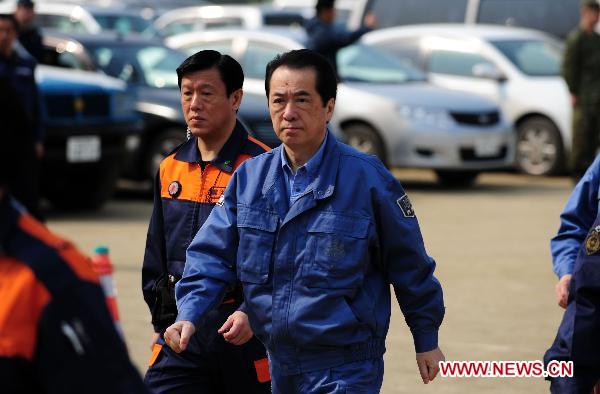Japan's nuclear struggle continues
 |
|
Japanese Prime Minister Naoto Kan (C) inspects the tsunami destroyed areas in Rikuzentakata city, Iwate prefecture, Japan, on April 2, 2011. [Xinhua/Ji Chunpeng] |
Japan's fight against its nuclear crisis suffered another setback on Sunday after efforts to cement a cracked concrete pit at a crippled nuclear reactor failed.
The nuclear complex has been spewing radioactivity since March 11, when a magnitude-9.0 earthquake and ensuing tsunami knocked out power, disabling its cooling systems and allowing radiation to spill from the overheating reactors.
On Saturday, crippled Fukushima Dai-ichi nuclear plant was found to have been discharging highly radioactive water into the Pacific Ocean.
Later in the day, Tokyo Electric Power Co. (TEPCO) said it had found a crack in the pit at its No.2 reactor, which they believed was the source of the contaminated water.
Soon after the discovery, the plant's operator started filling the pit with cement to seal the crack and prevent more contaminated water from seeping into the ocean.
However, after pouring concrete into the pit with a 20-centimeter crack, workers found the crack was still discharging heavy doses of radiation, which was over 4,000 times the legal limit.
After the failed attempt, TEPCO's engineers are struggling to devise new tactics such as using water-absorbent polymer to prevent further leakage of contaminated water into the sea.
Other options for cooling down the overheating reactors include an improvised air conditioning system, spraying the reactor fuel rods with vaporized water or using the plant's cleaning system, nuclear safety officials said.
According to Nuclear safety officials, the crack was likely caused by the quake and could be the source of radioactivity found in coastal waters in recent days.
The radioactive water quickly disperses in both air and water, and experts have said that it would be quickly diluted by the vast Pacific Ocean, where even large amounts have little effect.
As Japan is grappling with its hydra-headed nuclear disaster, an outpouring of international support reaches Japan to help it avert a nuclear catastrophe.
On Saturday afternoon, a 15-member advance party of a U.S. military radiation control team arrived at Japan on a mission to help deal with the nuclear crisis, Kyodo News Agency reported.
The full 155-strong Initial Response Force, comprising marines trained in chemical, biological, radiological, nuclear and high-yield explosion operations is deployed in Yokota from Indian Head, Maryland, according to Kyodo News Agency.
The force is capable of monitoring support, casualty search and rescue, personnel decontamination as well as emergency medical care.
On Wednesday, Anne Lauvergeon, chief executive of nuclear power giant Areva and one of France's most powerful female executives, arrived in Japan with three French experts on radioactive water contamination, saying that she planned to send staff to help handle the crisis.
One day later, French President Nicolas Sarkozy arrived in Tokyo to show solidarity with the disaster-hit nation.
"You are not alone in this crisis. The world is watching you and the world admires you," Sarkozy told Japanese Prime Minister Naoto Kan.
As fear of a possible meltdown in the crippled nuclear complex has eclipsed the plight of the homeless and huge casualties inflicted by the earthquake and tsunami, Japanese and U.S. soldiers Saturday conducted a joint search for bodies.
The task force has used dozens of ships and helicopters to comb through the land which is still submerged in the water along the northeast coast.
 0
0 







Go to Forum >>0 Comments